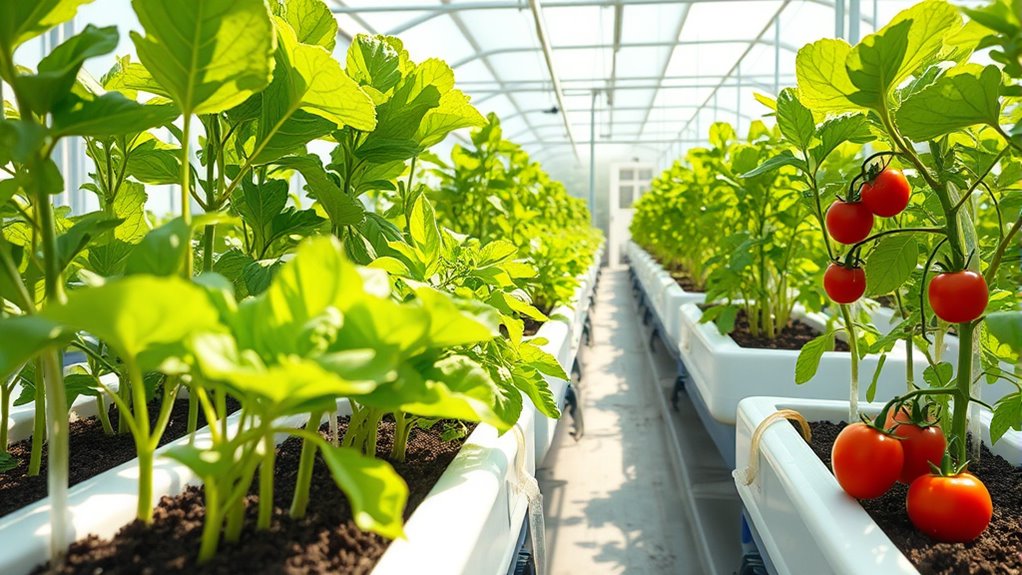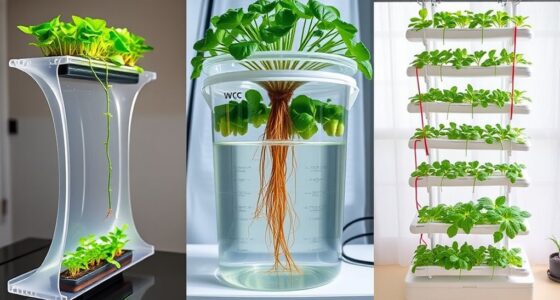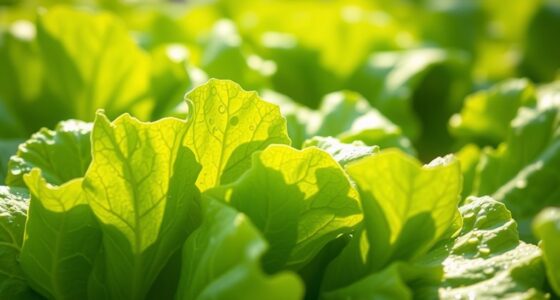Hybrid hydroponics blends soil-based methods with hydroponic systems, giving you more control over your plants. This approach enhances nutrient delivery, ensuring faster growth and better yields. It also helps buffer nutrient fluctuations and fosters healthy root zones. You can switch between containers with soil or soilless media as your plants develop. Keep exploring to discover how combining these techniques can optimize your gardening success and boost your harvest potential.
Key Takeaways
- Hybrid hydroponics combines soil and soilless systems for enhanced nutrient delivery and plant growth efficiency.
- It offers precise control over root zone conditions, reducing issues like root rot and nutrient imbalances.
- Incorporating soil elements buffers nutrient fluctuations, ensuring steady mineral supply for better yields.
- System flexibility allows growers to adapt methods based on plant growth stages for optimal results.
- This approach maximizes resource use, improves plant health, and promotes sustainable, higher-yield cultivation.

Have you ever wondered how combining different growing techniques can optimize your garden’s productivity? Hybrid hydroponics offers a compelling solution by blending soil-based methods with hydroponic systems. This approach allows you to leverage the strengths of both techniques, creating a versatile environment that can boost your yields and improve plant health. One of the key benefits of hybrid hydroponics is how it enhances nutrient delivery. Unlike traditional soil, hydroponic systems provide a direct pathway for nutrients to reach plant roots, resulting in faster growth and more efficient use of fertilizers. When you incorporate soil elements into your hydroponic setup, you can still benefit from natural nutrient reservoirs, which help buffer fluctuations and provide a steady supply of essential minerals. This synergy ensures your plants receive consistent nourishment, reducing the risk of deficiencies or excesses that can hinder growth. Additionally, monitoring expiration dates of nutrients and media can prevent potential issues with spoilage or contamination, ensuring optimal plant health. Root zone management is essential in hybrid hydroponics because it allows you to control the environment around your plant roots precisely. By combining soil and hydroponic components, you can tailor the root zone conditions to suit specific plant needs. For example, you might use a hydroponic system for rapid nutrient uptake while maintaining a soil bed that offers stability and natural microbial activity. This balance helps prevent issues like root rot or nutrient lockout, which are common in pure hydroponic setups. You can also optimize oxygenation around the roots by adjusting water flow or aeration levels, ensuring roots stay healthy and active. Managing the root zone effectively means you can adapt to different crop requirements, experiment with various mediums, and troubleshoot problems more efficiently. In practice, hybrid hydroponics involves integrating containers filled with soil or a soilless medium alongside traditional hydroponic systems like NFT or deep water culture. This setup enables you to switch between or combine methods based on plant stages or environmental conditions. For instance, seedlings might thrive in soil-based beds, benefiting from natural nutrients and microbial activity, while mature plants can be transferred to hydroponic systems for faster growth. The flexibility of hybrid systems also allows you to optimize resource use, conserving water and nutrients while maintaining high productivity. By carefully managing nutrient delivery and root zone conditions, you create a dynamic environment that supports healthy, vigorous plants. This innovative approach opens new possibilities for maximizing garden yields, making hybrid hydroponics an appealing choice for growers seeking efficiency and resilience.
Frequently Asked Questions
What Crops Are Best Suited for Hybrid Hydroponics Systems?
When choosing crops for hybrid hydroponics, you should consider crop selection and plant compatibility. Leafy greens like lettuce and spinach thrive, along with herbs such as basil and mint, due to their fast growth and adaptability. Tomatoes and peppers also perform well if managed properly. You’ll want to select crops that tolerate both soil and hydroponic conditions, ensuring ideal yields and healthy growth in hybrid systems.
How Does Hybrid Hydroponics Impact Resource Consumption Compared to Traditional Methods?
Think of hybrid hydroponics as a smart wallet—saving resources where it counts. You’ll notice reduced water consumption because plants reuse solutions, much like recycling. Nutrient efficiency improves because nutrients are delivered directly to roots, minimizing waste. Compared to traditional methods, you use less water and fertilizer, making your system more sustainable and cost-effective. This approach helps conserve water and optimize nutrients, giving you better yields with fewer resources.
What Are the Initial Setup Costs for Hybrid Hydroponics?
You’ll find that the initial setup costs for hybrid hydroponics depend on your cost analysis and equipment requirements. You might need to invest in specialized growing containers, nutrient delivery systems, and climate control equipment, which can be pricier than traditional soil gardening. However, these costs can vary based on the scale of your setup. Planning ahead helps you balance upfront expenses with long-term benefits, making it a worthwhile investment.
Can Hybrid Hydroponics Be Scaled for Commercial Farming?
Think of hybrid hydroponics as building your own spaceship; it’s ambitious but feasible. You can scale it for commercial farming, especially with ongoing technological innovations that improve efficiency and reduce costs. The key is evaluating the economical feasibility—balancing initial investments against long-term gains. With proper planning, resource management, and adaptation of new tech, you can turn small-scale hybrid systems into a profitable, sustainable large-scale operation.
What Are Common Challenges Faced in Maintaining Hybrid Hydroponic Systems?
When maintaining hybrid hydroponic systems, you often face challenges like nutrient imbalance, which can stunt plant growth, and pests or diseases that spread quickly. You need to monitor nutrient levels carefully and adjust them as needed. Regularly inspect plants for pests and diseases, and implement integrated pest management strategies. Staying vigilant and proactive helps you keep your hybrid system productive and healthy, ensuring better yields and long-term success.
Conclusion
Think of hybrid hydroponics as a garden symphony, where soil and water work together in harmony to create a bountiful harvest. Just as a skilled conductor blends different instruments for a richer sound, combining traditional and modern methods amplifies your yields. Embrace this approach, and you’ll discover the full potential of your garden—like a maestro guiding each element to produce a masterpiece of growth and abundance. Your thriving garden awaits this perfect harmony.











